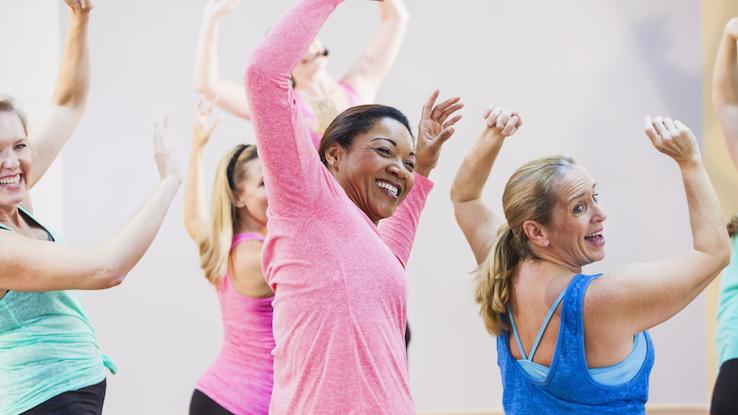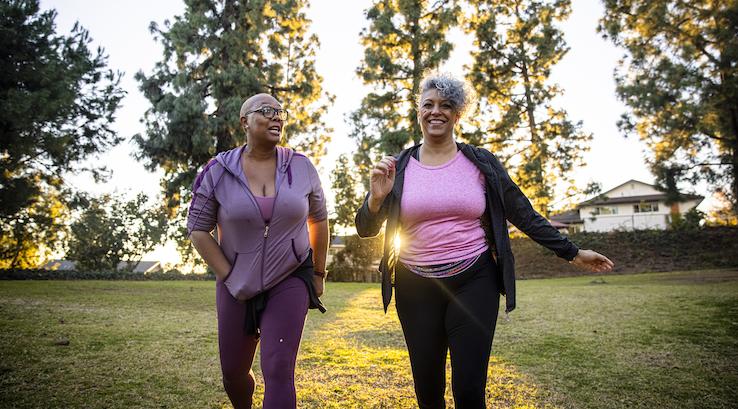
Osteoporosis is the loss of bone density. It makes bones weak and more likely to break. It’s more common in women and in older adults — so it’s important to take steps to protect your bones as you age.
Doing weight-bearing exercises is one of the best ways to manage and prevent osteoporosis. And strength training can also help keep your bones and muscles strong. Learn about the health benefits of these activities and how you can get started.
Exercise Has Lots of Benefits — for Osteoporosis and for Overall Health

While weight-bearing exercises and other physical activities are great for reducing the risk of osteoporosis, they also have a range of other health benefits, including:
- Less pain
- Better mood and sense of well-being
- Better balance, flexibility and coordination
- Improved heart health and endurance
Being active can also help older adults maintain their independence and ability to do daily tasks and activities.
And while osteoporosis is more common in older adults, it’s important to start getting physical activity earlier in life. You go through a period of rapid bone growth in your teens and early 20s, so that’s a key time to do weight-bearing exercises to build your bone density.
Lots of Things Count as Weight-Bearing Exercise

“Weight-bearing” means any activity that you do on your feet, and that works your muscles and bones against gravity. These exercises put healthy pressure on your bones and help keep them dense and strong.
Many daily activities count as weight-bearing exercise, including:
- Walking
- Cleaning
- Gardening
- Mowing the lawn
- Grocery shopping
- Going up and down the stairs
If you enjoy sports, playing sports is another great way to put healthy pressure on your bones. Sports like tennis, soccer, basketball and even bowling all count.
But if you’ve been diagnosed with osteoporosis, ask your doctor which sports and activities are safe for you. For example, you may need to avoid high-impact activities like running — or do them on an elliptical machine or padded track instead of asphalt.
Add Strength-Training Activities to Your Routine

This type of weight-bearing exercise uses free weights, resistance bands, weight machines or your own bodyweight to strengthen both your bones and your muscles. It’s especially important to strengthen your back, since osteoporosis can affect the spine. Here are some examples of the many strength-training exercises you can try.
Squats:
- Stand with feet slightly wider than shoulder-width apart.
- Slowly lower yourself down and then back up by bending at the knees.
- Try to keep your back straight throughout.
Lateral raises:
- Stand with feet shoulder-width apart and a weight in each hand.
- Raise your arms up and out to your sides until your arms are straight out from your shoulder.
- Beginners can start by doing one arm at a time instead of both at once.
Bicep curls:
- Stand with feet shoulder-width apart and a weight in each hand.
- Pull the weight up by bending at the elbow.
- Once the weight reaches your shoulder, slowly lower it back down to the starting position.
You can also do lateral raises and bicep curls with resistance bands instead of free weights.
Just be careful about exercises that involve excessive twisting or bending at the waist, like sit-ups. This can increase the risk of compression fractures in people with osteoporosis. Ask your doctor what types of strength-training exercises are right for you.
Bottom Line: Exercise Can Help Prevent and Treat Osteoporosis
Getting regular physical activity throughout your life is one of the best things you can do to prevent your bone health. And if you already have osteoporosis, exercise can strengthen your bones and help prevent fractures. Talk with your doctor and make an exercise plan to protect yourself from osteoporosis.
Resource Links:
- “Exercising with Osteoporosis: Stay Active the Safe Way” via Mayo Clinic
- “Exercise for Your Bone Health” via NIH Osteoporosis and Related Bone Diseases National Resource Center
- “Osteoporosis Prevention, Screening, and Diagnosis: ACOG Clinical Practice Guideline No. 1” via Obstetrics and Gynecology
- “International Exercise Recommendations in Older Adults (ICFSR): Expert Consensus Guidelines” via The Journal of Nutrition, Health & Aging
- “Role of Physical Activity in Bone-Muscle Crosstalk: Biological Aspects and Clinical Implications” via Journal of Functional Morphology and Kinesiology
- “Exercise vs Conventional Treatment for Treatment of Primary Osteoporosis” via Orthopaedic Surgery





